Page 1327 of 3342
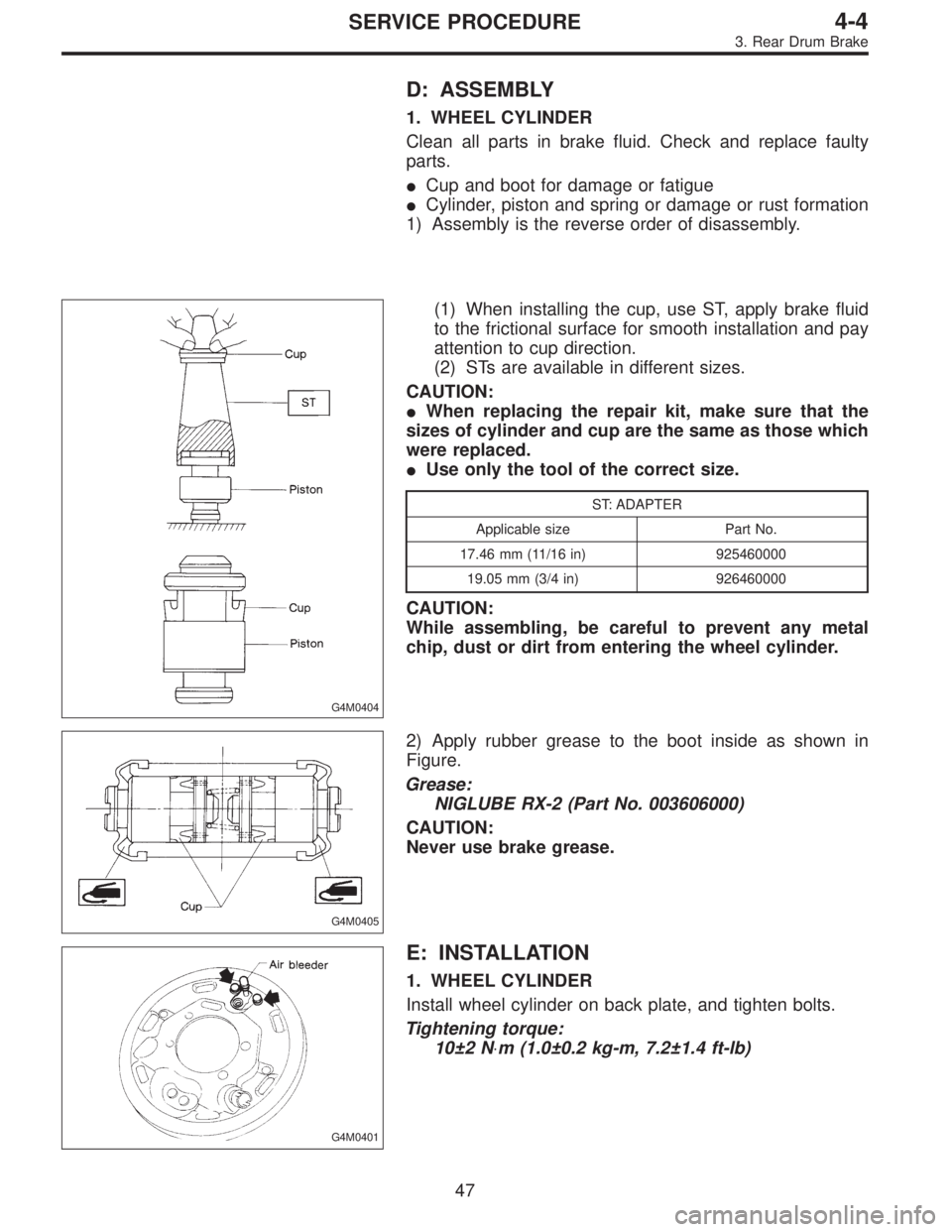
D: ASSEMBLY
1. WHEEL CYLINDER
Clean all parts in brake fluid. Check and replace faulty
parts.
�Cup and boot for damage or fatigue
�Cylinder, piston and spring or damage or rust formation
1) Assembly is the reverse order of disassembly.
G4M0404
(1) When installing the cup, use ST, apply brake fluid
to the frictional surface for smooth installation and pay
attention to cup direction.
(2) STs are available in different sizes.
CAUTION:
�When replacing the repair kit, make sure that the
sizes of cylinder and cup are the same as those which
were replaced.
�Use only the tool of the correct size.
ST: ADAPTER
Applicable size Part No.
17.46 mm (11/16 in) 925460000
19.05 mm (3/4 in) 926460000
CAUTION:
While assembling, be careful to prevent any metal
chip, dust or dirt from entering the wheel cylinder.
G4M0405
2) Apply rubber grease to the boot inside as shown in
Figure.
Grease:
NIGLUBE RX-2 (Part No. 003606000)
CAUTION:
Never use brake grease.
G4M0401
E: INSTALLATION
1. WHEEL CYLINDER
Install wheel cylinder on back plate, and tighten bolts.
Tightening torque:
10±2 N⋅m (1.0±0.2 kg-m, 7.2±1.4 ft-lb)
47
4-4SERVICE PROCEDURE
3. Rear Drum Brake
Page 1328 of 3342

G4M0407
2. BRAKE DRUM AND SHOE
1) Clean back plate and wheel cylinder.
2) Apply grease to portions indicated by arrows in Figure.
Brake grease:
Dow Corning Molykote No. 7439 (Part No.
725191460)
G4M0408
3) Apply grease to adjusting screw and both ends of
adjuster.
Brake grease:
Dow Corning Molykote No. 7439 (Part No.
725191460)
4) Connect upper shoe return spring to shoes.
G4M0409
5) While positioning shoes (one at a time) in groove on
wheel cylinder, secure shoes.
6) Connect lower shoe return spring.
7) Fix shoes by connecting hold-down cup to hold-down
pin.
G4M0400
3. BRAKE ASSEMBLY
1) Install brake assembly on housing, and tighten bolts to
install back plate.
Tightening torque:
52±6 N⋅m (5.3±0.6 kg-m, 38.3±4.3 ft-lb)
2) Install hub.
3) Connect brake pipe, and tighten brake pipe flange nut.
Tightening torque:
15
+3
�2N⋅m (1.5+0.3
�0.2kg-m, 10.8+2.2
�1.4ft-lb)
4) Set the outside diameter of brake shoes less than 0.5
to 0.8 mm (0.020 to 0.031 in) in comparison with the inside
diameter of brake drum.
5) Install brake drum.
6) After installing brake assembly, bleed air from brake
line.
48
4-4SERVICE PROCEDURE
3. Rear Drum Brake
Page 1329 of 3342
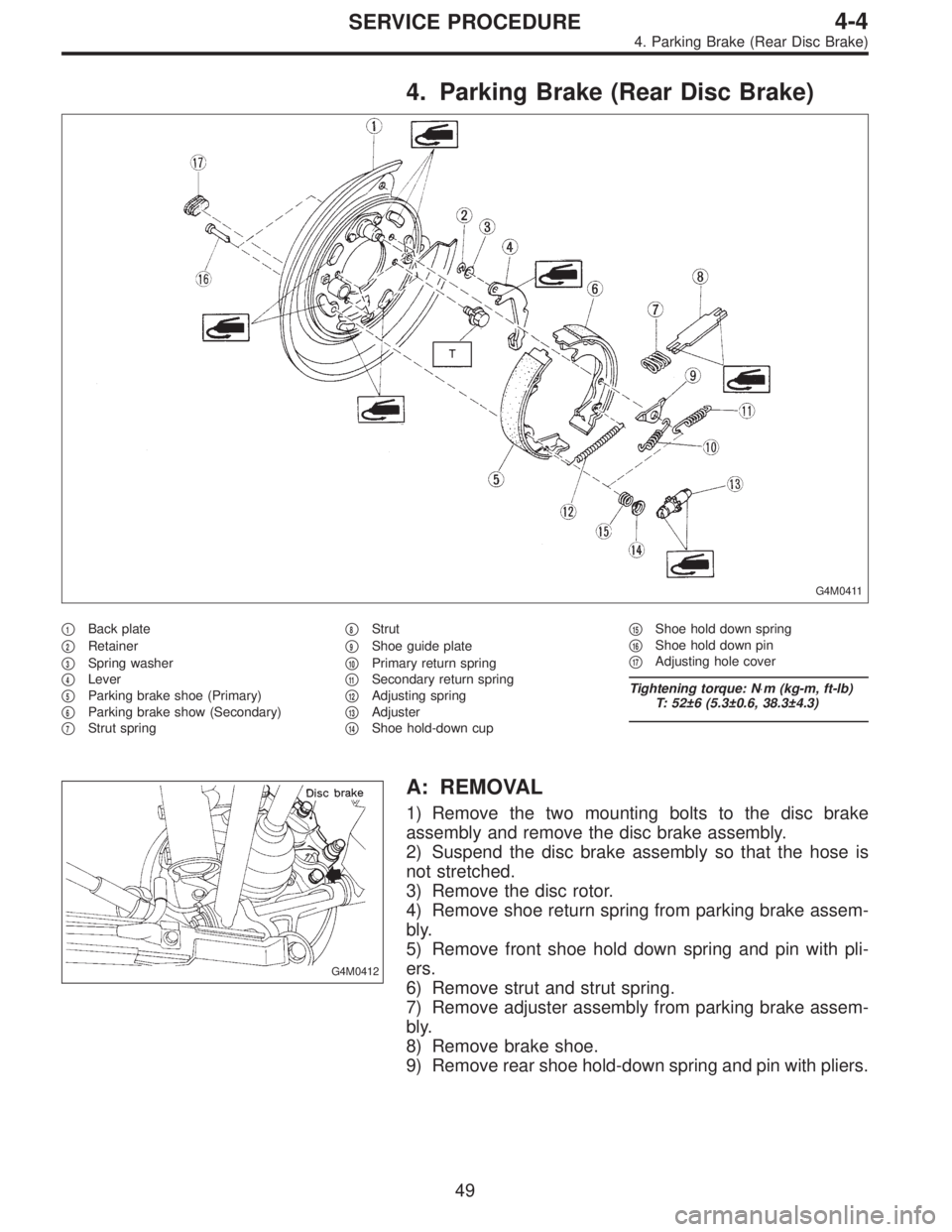
4. Parking Brake (Rear Disc Brake)
G4M0411
�1Back plate
�
2Retainer
�
3Spring washer
�
4Lever
�
5Parking brake shoe (Primary)
�
6Parking brake show (Secondary)
�
7Strut spring�
8Strut
�
9Shoe guide plate
�
10Primary return spring
�
11Secondary return spring
�
12Adjusting spring
�
13Adjuster
�
14Shoe hold-down cup�
15Shoe hold down spring
�
16Shoe hold down pin
�
17Adjusting hole cover
Tightening torque: N⋅m (kg-m, ft-lb)
T: 52±6 (5.3±0.6, 38.3±4.3)
G4M0412
A: REMOVAL
1) Remove the two mounting bolts to the disc brake
assembly and remove the disc brake assembly.
2) Suspend the disc brake assembly so that the hose is
not stretched.
3) Remove the disc rotor.
4) Remove shoe return spring from parking brake assem-
bly.
5) Remove front shoe hold down spring and pin with pli-
ers.
6) Remove strut and strut spring.
7) Remove adjuster assembly from parking brake assem-
bly.
8) Remove brake shoe.
9) Remove rear shoe hold-down spring and pin with pliers.
49
4-4SERVICE PROCEDURE
4. Parking Brake (Rear Disc Brake)
Page 1332 of 3342
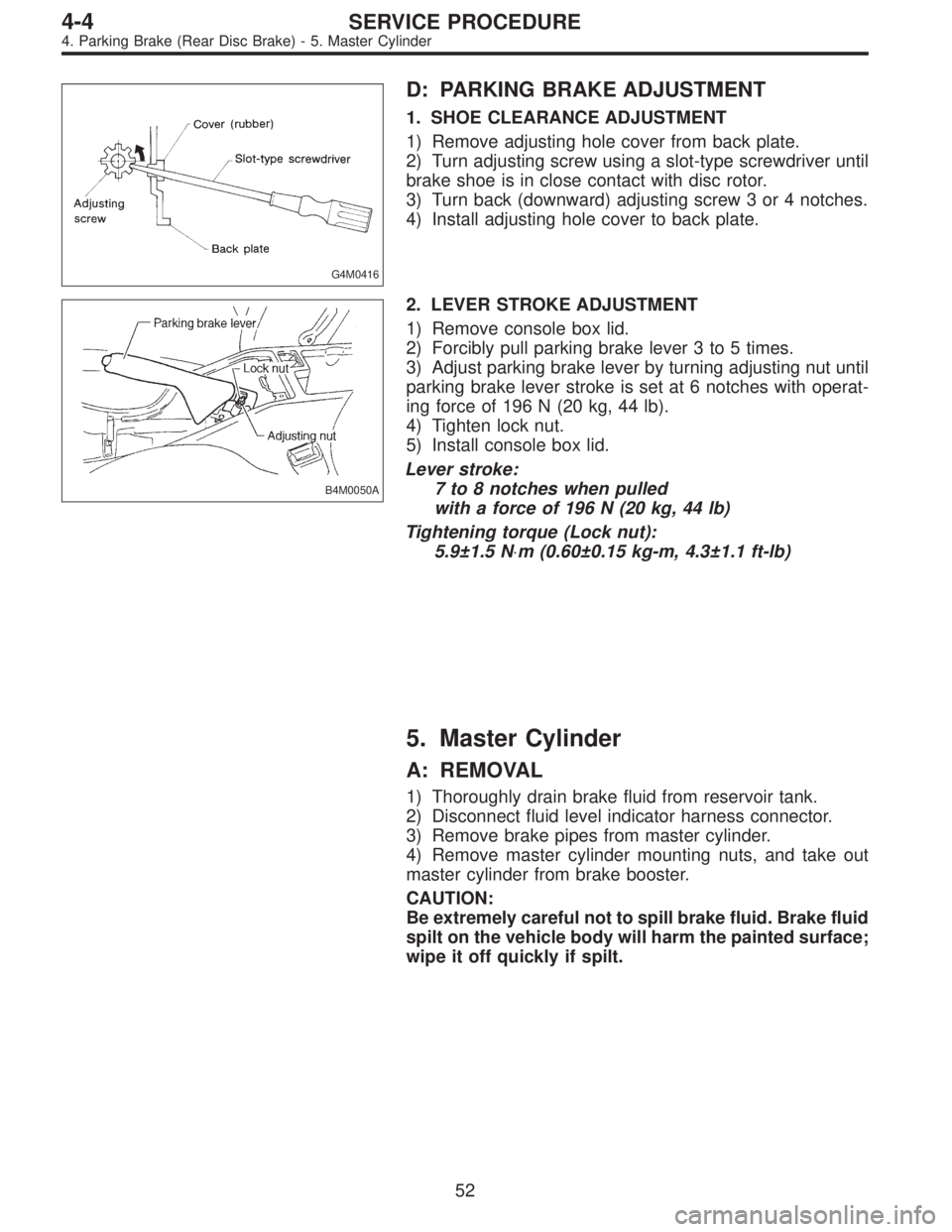
G4M0416
D: PARKING BRAKE ADJUSTMENT
1. SHOE CLEARANCE ADJUSTMENT
1) Remove adjusting hole cover from back plate.
2) Turn adjusting screw using a slot-type screwdriver until
brake shoe is in close contact with disc rotor.
3) Turn back (downward) adjusting screw 3 or 4 notches.
4) Install adjusting hole cover to back plate.
B4M0050A
2. LEVER STROKE ADJUSTMENT
1) Remove console box lid.
2) Forcibly pull parking brake lever 3 to 5 times.
3) Adjust parking brake lever by turning adjusting nut until
parking brake lever stroke is set at 6 notches with operat-
ing force of 196 N (20 kg, 44 lb).
4) Tighten lock nut.
5) Install console box lid.
Lever stroke:
7 to 8 notches when pulled
with a force of 196 N (20 kg, 44 lb)
Tightening torque (Lock nut):
5.9±1.5 N⋅m (0.60±0.15 kg-m, 4.3±1.1 ft-lb)
5. Master Cylinder
A: REMOVAL
1) Thoroughly drain brake fluid from reservoir tank.
2) Disconnect fluid level indicator harness connector.
3) Remove brake pipes from master cylinder.
4) Remove master cylinder mounting nuts, and take out
master cylinder from brake booster.
CAUTION:
Be extremely careful not to spill brake fluid. Brake fluid
spilt on the vehicle body will harm the painted surface;
wipe it off quickly if spilt.
52
4-4SERVICE PROCEDURE
4. Parking Brake (Rear Disc Brake) - 5. Master Cylinder
Page 1333 of 3342

G4M0416
D: PARKING BRAKE ADJUSTMENT
1. SHOE CLEARANCE ADJUSTMENT
1) Remove adjusting hole cover from back plate.
2) Turn adjusting screw using a slot-type screwdriver until
brake shoe is in close contact with disc rotor.
3) Turn back (downward) adjusting screw 3 or 4 notches.
4) Install adjusting hole cover to back plate.
B4M0050A
2. LEVER STROKE ADJUSTMENT
1) Remove console box lid.
2) Forcibly pull parking brake lever 3 to 5 times.
3) Adjust parking brake lever by turning adjusting nut until
parking brake lever stroke is set at 6 notches with operat-
ing force of 196 N (20 kg, 44 lb).
4) Tighten lock nut.
5) Install console box lid.
Lever stroke:
7 to 8 notches when pulled
with a force of 196 N (20 kg, 44 lb)
Tightening torque (Lock nut):
5.9±1.5 N⋅m (0.60±0.15 kg-m, 4.3±1.1 ft-lb)
5. Master Cylinder
A: REMOVAL
1) Thoroughly drain brake fluid from reservoir tank.
2) Disconnect fluid level indicator harness connector.
3) Remove brake pipes from master cylinder.
4) Remove master cylinder mounting nuts, and take out
master cylinder from brake booster.
CAUTION:
Be extremely careful not to spill brake fluid. Brake fluid
spilt on the vehicle body will harm the painted surface;
wipe it off quickly if spilt.
52
4-4SERVICE PROCEDURE
4. Parking Brake (Rear Disc Brake) - 5. Master Cylinder
Page 1335 of 3342
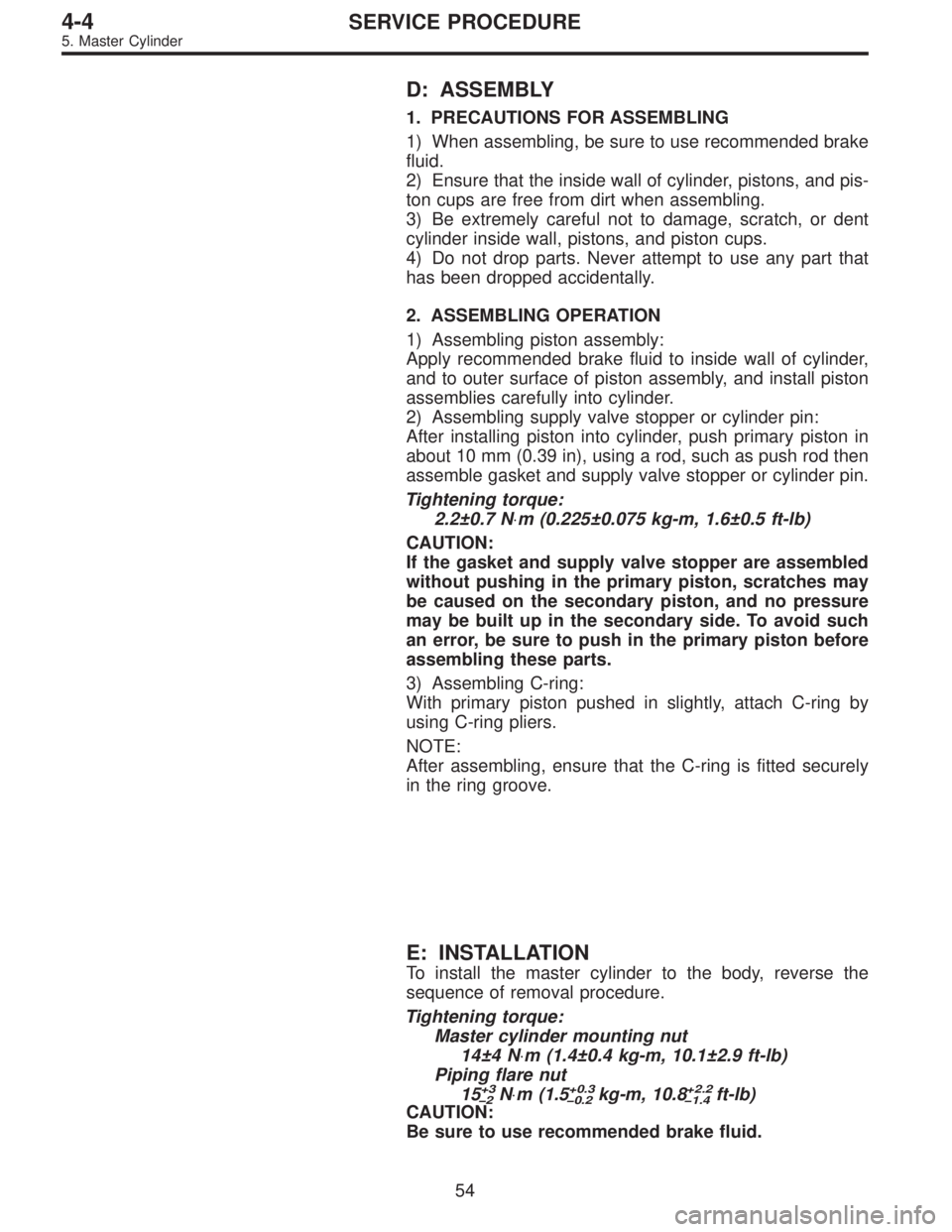
D: ASSEMBLY
1. PRECAUTIONS FOR ASSEMBLING
1) When assembling, be sure to use recommended brake
fluid.
2) Ensure that the inside wall of cylinder, pistons, and pis-
ton cups are free from dirt when assembling.
3) Be extremely careful not to damage, scratch, or dent
cylinder inside wall, pistons, and piston cups.
4) Do not drop parts. Never attempt to use any part that
has been dropped accidentally.
2. ASSEMBLING OPERATION
1) Assembling piston assembly:
Apply recommended brake fluid to inside wall of cylinder,
and to outer surface of piston assembly, and install piston
assemblies carefully into cylinder.
2) Assembling supply valve stopper or cylinder pin:
After installing piston into cylinder, push primary piston in
about 10 mm (0.39 in), using a rod, such as push rod then
assemble gasket and supply valve stopper or cylinder pin.
Tightening torque:
2.2±0.7 N⋅m (0.225±0.075 kg-m, 1.6±0.5 ft-lb)
CAUTION:
If the gasket and supply valve stopper are assembled
without pushing in the primary piston, scratches may
be caused on the secondary piston, and no pressure
may be built up in the secondary side. To avoid such
an error, be sure to push in the primary piston before
assembling these parts.
3) Assembling C-ring:
With primary piston pushed in slightly, attach C-ring by
using C-ring pliers.
NOTE:
After assembling, ensure that the C-ring is fitted securely
in the ring groove.
E: INSTALLATION
To install the master cylinder to the body, reverse the
sequence of removal procedure.
Tightening torque:
Master cylinder mounting nut
14±4 N⋅m (1.4±0.4 kg-m, 10.1±2.9 ft-lb)
Piping flare nut
15
+3
�2N⋅m (1.5+0.3
�0.2kg-m, 10.8+2.2
�1.4ft-lb)
CAUTION:
Be sure to use recommended brake fluid.
54
4-4SERVICE PROCEDURE
5. Master Cylinder
Page 1337 of 3342
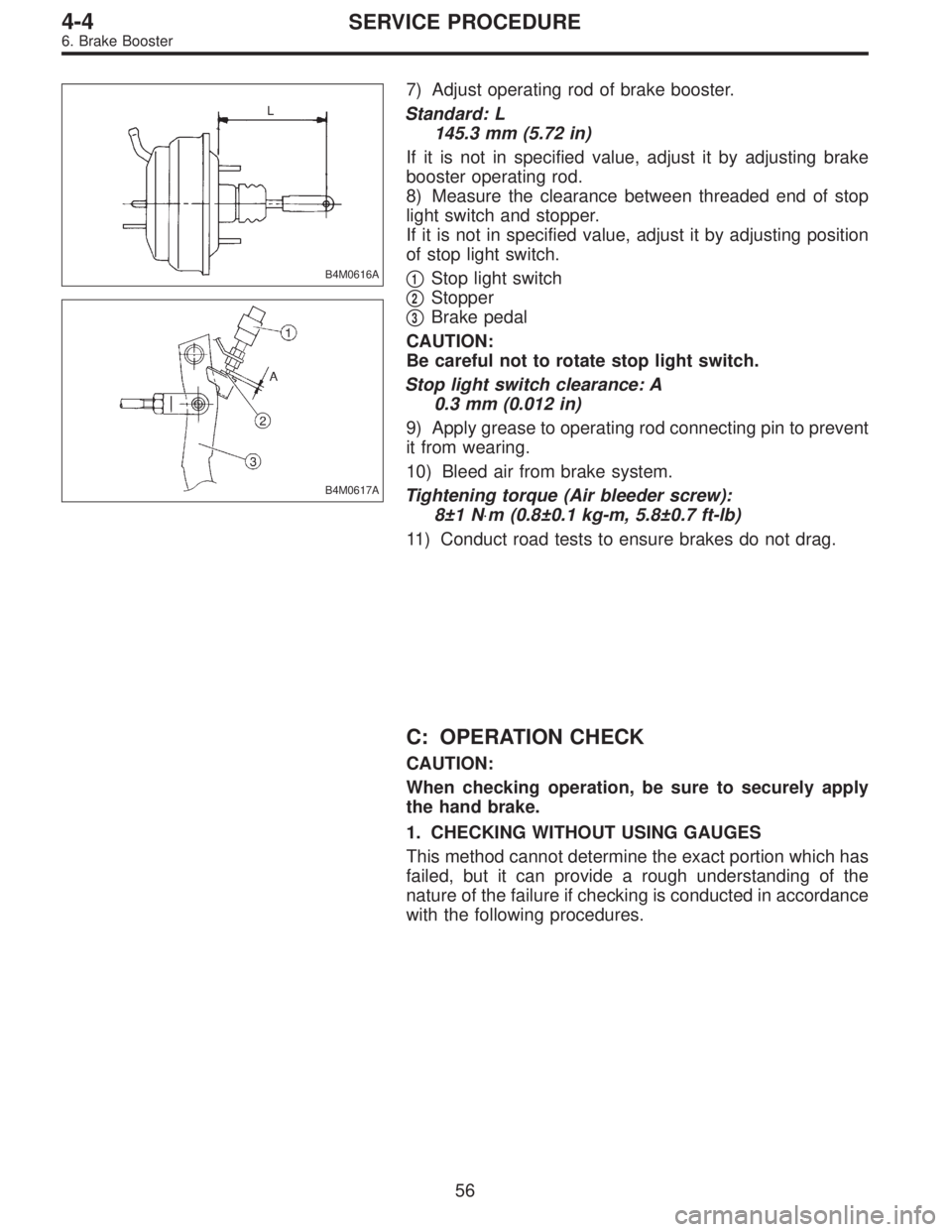
B4M0616A
B4M0617A
7) Adjust operating rod of brake booster.
Standard: L
145.3 mm (5.72 in)
If it is not in specified value, adjust it by adjusting brake
booster operating rod.
8) Measure the clearance between threaded end of stop
light switch and stopper.
If it is not in specified value, adjust it by adjusting position
of stop light switch.
�
1Stop light switch
�
2Stopper
�
3Brake pedal
CAUTION:
Be careful not to rotate stop light switch.
Stop light switch clearance: A
0.3 mm (0.012 in)
9) Apply grease to operating rod connecting pin to prevent
it from wearing.
10) Bleed air from brake system.
Tightening torque (Air bleeder screw):
8±1 N⋅m (0.8±0.1 kg-m, 5.8±0.7 ft-lb)
11) Conduct road tests to ensure brakes do not drag.
C: OPERATION CHECK
CAUTION:
When checking operation, be sure to securely apply
the hand brake.
1. CHECKING WITHOUT USING GAUGES
This method cannot determine the exact portion which has
failed, but it can provide a rough understanding of the
nature of the failure if checking is conducted in accordance
with the following procedures.
56
4-4SERVICE PROCEDURE
6. Brake Booster
Page 1342 of 3342
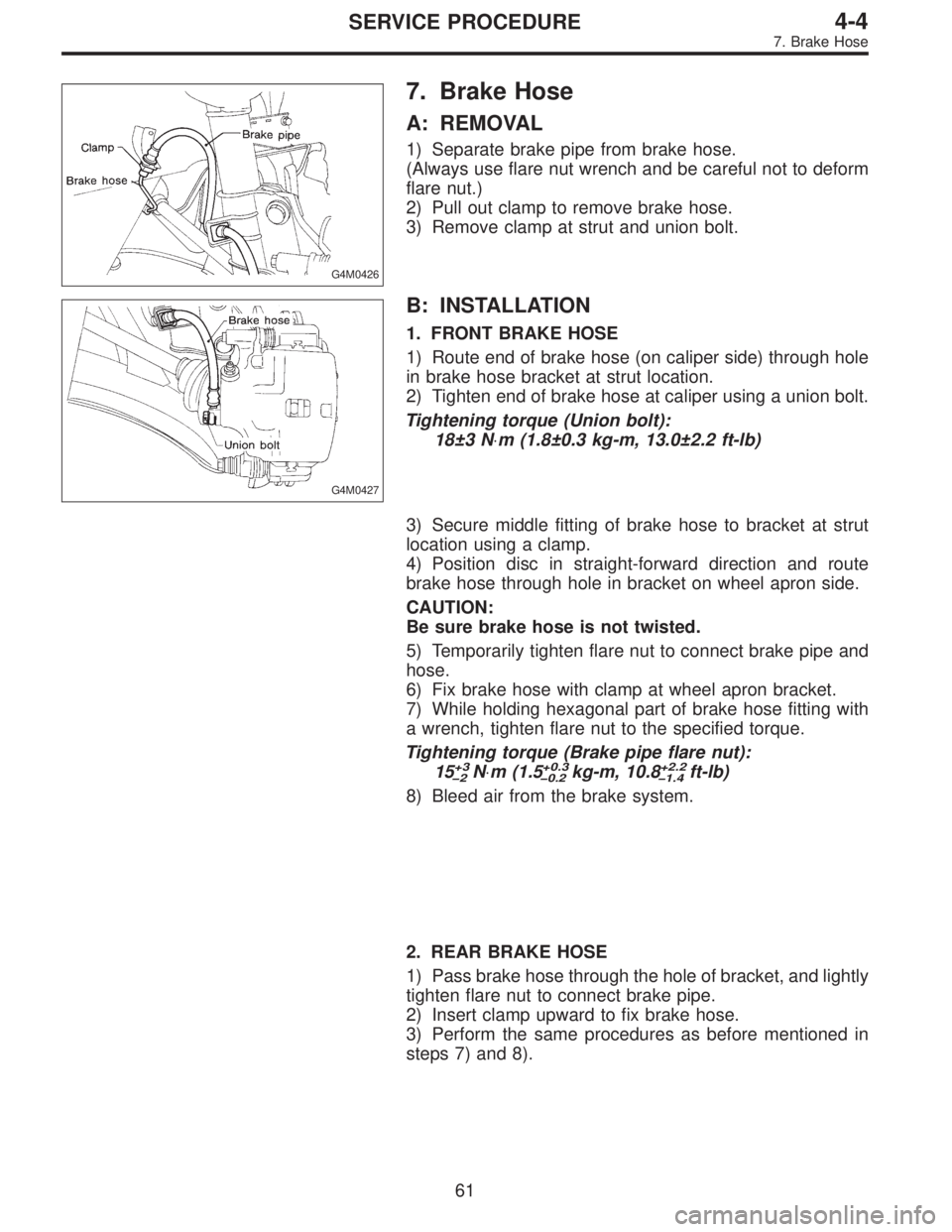
G4M0426
7. Brake Hose
A: REMOVAL
1) Separate brake pipe from brake hose.
(Always use flare nut wrench and be careful not to deform
flare nut.)
2) Pull out clamp to remove brake hose.
3) Remove clamp at strut and union bolt.
G4M0427
B: INSTALLATION
1. FRONT BRAKE HOSE
1) Route end of brake hose (on caliper side) through hole
in brake hose bracket at strut location.
2) Tighten end of brake hose at caliper using a union bolt.
Tightening torque (Union bolt):
18±3 N⋅m (1.8±0.3 kg-m, 13.0±2.2 ft-lb)
3) Secure middle fitting of brake hose to bracket at strut
location using a clamp.
4) Position disc in straight-forward direction and route
brake hose through hole in bracket on wheel apron side.
CAUTION:
Be sure brake hose is not twisted.
5) Temporarily tighten flare nut to connect brake pipe and
hose.
6) Fix brake hose with clamp at wheel apron bracket.
7) While holding hexagonal part of brake hose fitting with
a wrench, tighten flare nut to the specified torque.
Tightening torque (Brake pipe flare nut):
15
+3
�2N⋅m (1.5+0.3
�0.2kg-m, 10.8+2.2
�1.4ft-lb)
8) Bleed air from the brake system.
2. REAR BRAKE HOSE
1) Pass brake hose through the hole of bracket, and lightly
tighten flare nut to connect brake pipe.
2) Insert clamp upward to fix brake hose.
3) Perform the same procedures as before mentioned in
steps 7) and 8).
61
4-4SERVICE PROCEDURE
7. Brake Hose